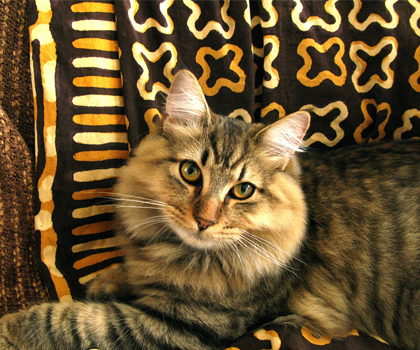
History
American Bobtails are loving and incredibly intelligent cats possessing a distinctive wild appearance. They are extremely interactive cats that bond with their human family with great devotion. They can both entertain through their antics at one moment and provide their owners a warm, soft shoulder to cry on in times of distress. American Bobtails are known for their love of games and can play fetch or hide and seek for hours on end. They will often initiate games with their owners, and they demonstrate their hunting instincts in the home by catching in mid-air flying insects that make the fatal mistake of entering their territory. No one length is preferred, and no two tails are the same. The natural bobtail is clearly visible above the back when the cat is alert, and it should not extend beyond the hind hock. This is a slow maturing breed, taking two to three years to reach its adult size. Females are generally proportionately smaller than males.
Description
They are medium to large cats with substantial rectangular bodies. The tail is short, expressive, and flexible and may be straight, slightly curved, slightly kinked, or have bumps along its length.
Grooming and Physical Needs
Size: The American Bobtail is a medium-size, muscular cat weighing around 16 pounds.
- Grooming Needs: The American Bobtail’s coat doesn’t usually mat or tangle as long as you comb or brush it a couple of times a week.
- Coat Type: The shorthaired American Bobtail actually has a medium-length double coat with hard outer hairs overlaying a soft, downy undercoat.
- Moulting: Sheds more in spring & fall.
- Exercise Needs: This is a smart cat who enjoys puzzle toys, learning tricks, and playing fetch.
- Average Life Span: 11-15 years
- Healthcare: American Bobtails are quite healthy Cats.
Behaviour
- Family: The social and laidback American Bobtail likes to play, so he’s a good choice for families with children.
- Temperament: These cats are devoted to their people, follows them around, loves to play, walks nicely on a leash after some training and welcomes guests with a smile.
- Trainability: Fairly easy to leash train and loves learning tricks such as fetch.
- Sociability (Other Pets): Happy to live with other cats and cat-friendly dogs.
- Meowing: They aren't as vocal as some breeds, but they docommunicate pleasure with chirps, clicks and trills, as well as the standard purr and meow.
Notes
All information courtesy of the Cat Fancier’s Association
